Voices of Biotech
Podcast: MilliporeSigma says education vital to creating unbreakable chain for sustainability
MilliporeSigma discusses the importance of people, education, and the benefits of embracing discomfort to bolster sustainability efforts.
December 1, 2012
After nearly a year of planning, BPI announced the winners of its first awards program on the evening of 9 October 2012, during the BioProcess International Conference. Award finalists, sponsors, and guests joined us for a banquet ceremony in the Providence, RI, Convention Center to honor the 36 finalists for our Decade of BioProcess awards — and announce the 12 winners.
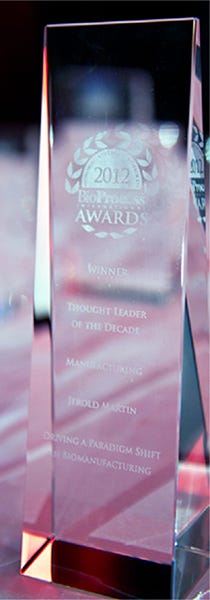
In his welcoming comments to the 150 attendees, BPI publisher Brian Caine noted that “during this decade, the finalists in this room have all championed the bioprocessing industry. Their tireless work ethic, imagination, and enduring vision have enabled the industry to undergo a dramatic transformation, to make incredible technological advances, and essentially rewrite the book on how to develop and manufacture biotherapeutics more effectively and less expensively.
“Because of you, we can better diagnose and treat illnesses and prevent diseases. And although we are here to celebrate your accomplishments tonight, we also celebrate the biotechnology industry’s continuing contributions to improving the quality of human lives around the world.”
The awards program was organized according to what we refer to as the three pillars of biomanufacturing: upstream processing, downstream processing, and manufacturing. Within each pillar, four awards honored the technology, technology application, collaboration, and thought leader of the past decade. The “Awards Methodology Tabulation” box explains our process.
Each nomination included up to 1,100 words of supporting narrative. All finalist entries were described in BPI’s September issue insert with text excerpted from those narratives and can be found online at http://awards.bioprocessintl.com/finalists.
This report now highlights the winning entries, with comments from some of those who were so highly honored by their peers. The nominated technologies and collaborations of the past 10 years clearly provide a strong foundation for innovations to come. Prominent themes of the past decade, as reflected in our winning entries, have included the achievement of higher production titers, the future of single-use technologies, the interest in perfusion technologies, the desire to replace protein A, and the need for both flexible and continuous processing. Forward-looking statements from award winners and conference presenters alike are building on these accomplishments and revealing great expectations for the next decade of our industry. The staff of BioProcess International looks forward to celebrating your continuing accomplishments with you.
Upstream Processing Pillar Winners
Technology of the Decade The WAVE Bioreactor: An Early Disruptive Technology — GE Healthcare
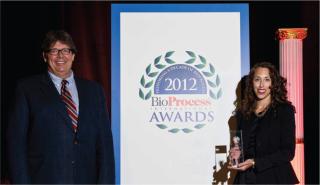
Finalists, “A Decade of BioProcess” Awards Jeff Craig (ATMI) presented the upstream technology award to Daniella Kranjac, business development leader — Enterprise Solutions, GE Healthcare. ()
Although this technology was introduced before the BPI Award Program’s 10-year anniversary span, it is impossible to look at the past decade’s strong emphasis on single-use manufacturing without crediting the influence of this transformative design. Because so many of the technologies honored by our program are indebted to this technology, it was fitting that our evening ceremony began with this award.
In the 1990s, most industrial cell-culture operations were designed with fixed tanks that required months to install, test, and validate before they could be put into use. The WAVE Bioreactor technology virtually eliminated time-consuming steps of cleaning, preparing, sterilizing, and maintaining cell culture tanks. One person could manage as many as 20 bioreactors, all while maintaining optimal conditions for cell growth. The new design enabled cell culture to be performed in presterilized plastic bags. Those bags — called Cellbags — are single-use bioreactors. This design eliminated the need for cleaning, sterilization, and associated validation. The gamma-irradiated bags reduce the risk of contamination due to equipment malfunction or operator error typical of traditional bioreactors such as stirred tanks, spinners, and hollow-fiber systems.
Following the introduction of the WAVE Bioreactor design in the mid-1990s, the landscape of cell culture from lab to production scale began to change dramatically. The WAVE system was the world’s first true single-use bioreactor, the first GMP-ready technology for single-use manufacturing. By the time BPI published its first single-use supplement in 2004, this bioreactor had already paved the way for a prolonged revolution in the industry’s approach to manufacturing. Today, single-use bioreactors are the default choice for seed train and clinical manufacturing operations. The proliferation of single-use technology continues to be aided by the wide success of this pioneering design.
Technology Application of the Decade Optimizing Cell Retention Using Perfusion Cultivation — Bayer Healthcare Cell Culture Development Group (US) and Bayer Technology Services (Germany)
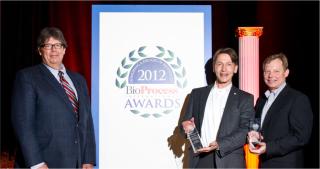
Finalists, “A Decade of BioProcess” Awards Stephen Garger accepted the technology application award on behalf of Bayer Healthcare Cell Culture Development Group, and Helmut Brod accepted on behalf of Bayer Technology Services. ()
Perfusion cultivation of mammalian cells can be used with complex and unstable biotherapeutics such as recombinant Factor VIII that cannot be manufactured using a traditional fed-batch approach. Full-length rFVIII is the largest and most complex biopharmaceutical in the market today, with 20 N-linked and at least seven O-linked glycosylation sites. In addition, rFVIII is highly unstable: Exposure to cell culture temperatures of 37 °C results in significant reduction in activity in less than 24 hours. The perfusion process honored here was designed at Bayer to produ
ce this highly complex and unstable molecule with the correct glycosylation profile.
Helmut Brod offered his thoughts about how this application has progressed and how it reflects current industry endeavors.
“Perfusion technology has matured a lot in the past decade. It used to be considered technologically complex and a speciality you would apply only if you could not avoid it — e.g. for very unstable products. Nowadays, with improved and novel technologies for cell retention and the strongly grown experience in the industry, it is becoming more and more an option you may wish to have in your portfolio and decide case by case whether it adds value to your operations or not.
“Today, many players in the industry do consider it even for manufacturing stable molecules such as monoclonal antibodies (MAbs). The expected benefit is then not so much overcoming challenges imposed by the molecule but rather gaining in economics by intensified processing, lower space consumption, and better plant utilization. It is also in line with the efforts of some industry players to introduce continuous processing into biomanufacturing to a much bigger extent than established today.”
We asked him whether Bayer’s work was well represented in the conference presentations that week. Brod noted that perfusion fermentation was pioneered by Bayer and others even before this past decade, “but its vitality and importance were highlighted during the conference in presentations by Bayer and, even more intensively, Genzyme.” When we asked him about technologies that we might be honoring in the future — especially those that were topics of that week’s conference presentations — he pointed to ADC processing technology and technological instruments for facilitating cell therapy. And looking ahead to our 20-year awards program in 2022, he predicts that we will be honoring technologies for manufacturing chemically modified proteins (PEGylation and ADCs) and about advancements in continuous drug-substance manufacturing.
Collaboration of the Decade Worldwide Supply and Distribution Agreements to Develop Novel Filtration Systems (Refine Technology, GE Healthcare, and Sartorius Stedim Biotech)
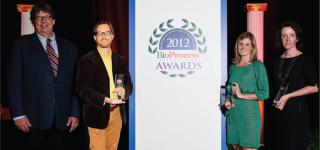
Finalists, “A Decade of BioProcess” Awards Accepting the upstream collaboration award on behalf of their companies are John Bonham-Carter (Refine Technology), Jessica Martin (Sartorius Stedim Biotech) and Lorraine Attridge (GE Healthcare). ()
Nominations in this category reflected current directions in partnering models, especially in collaborations of manufacturers with supplier companies. As described in the nomination narrative, Refine Technology’s objective was to dramatically reduce the risk and cost of upstream processing through continuous culture and process intensification. The company signed a worldwide supply and distribution agreement with GE Healthcare, which supplies hollow-fiber filtration cartridges for use with Refine’s ATF (alternating tangential flow) system for perfusion cell culture.
Additionally, Sartorius Stedim Biotech and Refine Technology then collaborated toward developing a robust platform for high-density perfusion cell cultivation, enabling fast and easy connection of the ATF System to SSB’s single-use BIOSTAT bioreactors. SSB and Refine Technology provided users with initial application and protocol guidance for these connections.
Finalists, “A Decade of BioProcess” Awards
UPSTREAM PROCESSING
Technology of the Decade Award
(Winner) The Wave Bioreactor: An Early Disruptive Technology (GE Healthcare)
ATF (Alternating Tangential Flow) System (Refine Technology)
The First Single-Use, Stirred-Tank Cell Culture Bioreactor (SUB) (Thermo Scientific)
Technical Application of the Decade Award
(Winner) Bayer Cell Culture Development Group (US) and Technology Services (Germany) — Optimizing cell retention using perfusion cultivation
GSK and Pfenex — Micro-24/Cellerator (from Microreactor Technologies)
Therapeutic Proteins International, LLC — Single-use technology for production of bacterial proteins
Collaboration of the Decade Award
(Winner) Worldwide supply and distribution agreements to develop novel filtration systems (Refine Technology, GE Healthcare, and Sartorius Stedim Biotech)
Genomic sequencing of the Chinese hamster genome database (CHO Genome User Group)
Xcellerex AMP program team (DARPA–AMP) (Xcellerex, Pfenex, deltaDOT, Ltd., BioPharm Services, Inc., and the Latham BioPharm Group, Inc.)
Thought Leader of the Decade Award
(Winner) Parrish Galliher — technologist and entrepreneur (Xcellerex)
Chetan T. Goudar — a champion of systems biology (Amgen, Thousand Oaks)
Jerold Martin — industry spokesperson and single-use champion (Pall Life Sciences, BPSA)
DOWNSTREAM PROCESSING
Technology of the Decade Award
(Winner) IBD™ Inline Buffer Dilution Systems (Asahi Kasei Bioprocess)
Planova™ virus-removal filters (Asahi Kasei Bioprocess)
Viresolve Pro and Pro+ (EMD Millipore)
Technical Application of the Decade Award
(Winner) Percivia, LLC (Blanca Lain et al.) — assessing Toyopearl brand GigaCap S-650M media (Tosoh Bioscience)
Amgen Technology — Computational fluid dynamics (CFD)
Human Genome Sciences — Optimization and Scale-Up of Ultrafiltration/Diafiltration in Clinical Manufacturing
Collaboration of the Decade Award
(Winner) New affinity-ligand–based chromatographic media (GE Healthcare and BAC BV)
ProSep® Ultra Plus chromatography media (University of Applied Sciences Biberach, Boehringer Ingelheim, Rentschler Biotechnologie GmbH, and the Karlsruhe Institute of Technology (KIT))
Minibody purification (Validated Biosystems, City of Hope Medical Center’s Beckman Research Institute, and the Crump Institute for Molecular Imaging’s Department of Molecular and Medical Pharmacology at UCLA’s David Geffen School of Medicine)
Thought Leader of the Decade Award
(Winner) Günter Jagschies — a visionary leader in pursuit of industrial excellence (GE Healthcare Life Sciences)
Jerold Martin — driving best practices for single-use adoption (Pall Corporation)
Duncan Low — downstream processing pioneer (Amgen)
MANUFACTURING
Technology of the Decade Award
(Winner) Steam-Thru connections — pioneering technology for hybrid systems (Colder Products Company)
Crystalomics technology — delivering highly concentrated biologics (Althea Technology)
Innovative development of single-use applications (Sartorius Stedim Biotech)
Technical Application of the Decade Award
(Winner) ReGenesys — The Quantum cell expansion system, a disposable kit from Terumo BCT for automated stem cell culture
Genzyme Corporation — Data collection and analysis during preformulat
ion of biotherapeutic proteins
Vetter Pharma International GmbH — Clinical Trial Solutions for Filling Drug-Delivery Systems, Vetter Development Service, Chicago, IL
Collaboration of the Decade Award
(Winner) NIBRT (National Institute for Bioprocessing Research and Training) (Irish government, industry, and academia)
Trusted Partner Network (TPN) — a capacity-sharing strategy (Merck and Medimmune)
PDA: An important interface between industry and regulators (PDA and its members)
Thought Leader of the Decade Award
(Winner) Jerold Martin — driving a paradigm shift in biomanufacturing (Pall Corporation)
Jim Akers — building a foundation of aseptic processing (Akers Kennedy & Associates)
Andrew Sinclair — developing product lifecycle management tools (Biopharm Services Ltd.)
Additional information about these nominations can be found at http://awards.bioprocessintl.com/finalists.
Statements from combined press releases (www.bioprocessintl.com/press-releases/Sartorius-Stedim-Biotech-and-Refine-Technology-Announce-Cooperation-326176) point to the goals of this ongoing relationship as a platform for future collaboration, “a crucial step in helping both companies meet the new and emerging demands of the rapidly-changing biomanufacturing market. The relationship also helps support the FDA’s goal of achieving continuous processing across the industry.” As stated by John Bonham-Carter, vice president of Refine Technology’s sales and business development, the company’s objective has been “to dramatically reduce the risk and cost of upstream processing through continuous culture and process intensification.” This collaboration is an excellent reflection of some creative ways in which suppliers and manufacturers alike are responding to market needs.
Our Panel of Judges
The staff of BioProcess International extends its sincere thanks to our panel of judges, who graciously donated their time (and patience!) to our inaugural awards program.
Jianguo Yang, principal scientist, Genzyme
Denny Kraichely, associate sirector, Janssen Pharmaceutical
Anthony Lubiniecki, vice president, Centocor
Curran Simpson, senior vice president, Human Genome Sciences
Jean Bender, director, MedImmune
Gregory Zarbis-Papastoitsis, senior director bioprocess research and development, Eleven Biotherapeutics
Laure Dykas, process scientist, Protein Science
Barbara Immel, GMP specialist, Immel Resources
James Blackwell, president, The Windshire Group
Bruce Compton, principal, Compton Associates
Siddharth Advant, senior director, ImClone Systems
Adam Goldstein, senior manager, Genentech
Thought Leader of the Decade Parrish Galliher, Technologist and Entrepreneur (Xcellerex, part of GE Healthcare Life Sciences)
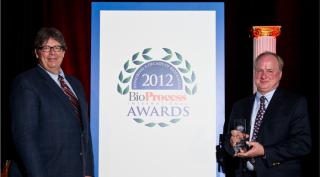
Finalists, “A Decade of BioProcess” Awards Parrish Galliher accepts the upstream thought leader award. ()
The nomination for Parrish Galliher began with this comment: “There are technologists who come up with great ideas and entrepreneurs who found companies to develop technologies. Parrish is part of the rare breed that does both.”
In promoting the industry’s move to single-use reactors, Galliher has been instrumental in helping companies save significant time and money in development and manufacturing of important biologics. Xcellerex’s recent purchase by GE should further enhance this “revolution.”
Galliher made significant personal and professional sacrifices to forward his vision of a truly modular disposable facility powered by a relatively large-scale single-use bioreactor. He took on substantial risk in founding Xcellerex based on his unwavering belief in this manufacturing approach.
Under his leadership, Xcellerex has also participated in ground-breaking collaborative work under DARPA and DTRA contracts to develop technologies for accelerated MAb and vaccine manufacturing.
Downstream Processing Pillar Winners
Technology of the Decade IBD Inline Buffer Dilution Systems (Asahi Kasei Bioprocess)
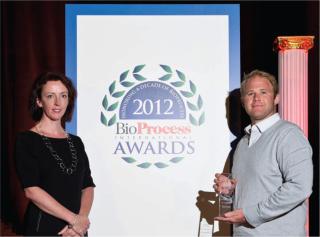
Awards Methodology Tabulation Process Accepting the award from downstream sponsor representative Lorraine Attridge of GE Healthcare is John Fisher, senior manager for science and technology at Asahi Kasei. ()
Increased protein titers from upstream processes require substantial quantities of diluted buffers for downstream processing. Introduced in 2007, IBD systems help manufacturers prepare 1× binary and ternary buffer blends from ≤20× salt-solution concentrates for purification.
Process analytical technology controls pH and conductivity simultaneously, and large buffer tanks are replaced with disposable bags. The systems minimize batch variation and reduce the need to discard/reprocess buffers that fail required specifications. Direct cost savings come from reduced capital expenses for large-volume buffer hold tanks, reduced operating costs (offline buffer QC, tank cleaning, and cleaning validation), and improved turnaround times.
As described in the nomination, the technology has helped biopharmaceutical manufacturers across four continents, and the company is beginning a second surge of IBD implementations with the ramp-up of offshore biosimilars manufacturing.
Awards Methodology Tabulation Process
BPI opened nominations in January 2012 and closed them at the end of June 2012. The nomination data (an average 1,100 words of short narratives in each ballot) were exported to a ballot template. BPI solicited the help of at least three judges assigned to each pillar, and each judge reviewed all nominations for each pillar. The editors monitored this process to ensure that no conflicts of interest had any critical impact on the final results.
The judges then emailed each ballot directly to our contact at Deloitte and Touche. Our contact at that firm then returned to us the three highest scoring entries in each category. The editorial team was prepared to resolve any ties. Other than one finalist entry that had to be withdrawn late in the process for corporate/legal reason
s, our final results are as determined through this process.
Technology Application of the Decade Development of a High Capacity MAb Capture Step to Replace Protein A (Percivia, LLC)
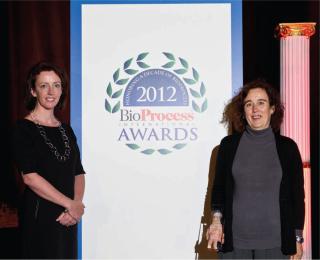
Our Event Sponsors Accepting the downstream technology application award on behalf of her coauthors is Blanca Lain, formerly of Percivia, LLC ()
The award for downstream technology application was presented to the authors of a BPI paper written while the authors were still with Percivia — before that business was discontinued. The nomination narratives reflected on the significance of this work as a well-defined exploration into reducing the cost and complexity of downstream processing (www.bioprocessintl.com/journal/2009/May/Development-of-a-High-Capacity-MAb-Capture-Step-Based-on-Cation-Exchange-Chromatography-183798).
As the industry moves toward high–cell-density and high-titer processes to reduce cost of goods, downstream development is challenged by the scarcity of high capacity purification processes. Process engineers are forced to develop and scale up complex technologies requiring extensive automation and, as a result, increase risk of failure. The authors described a simple yet powerful and economic use of a high-capacity chromatography medium to process high-titer MAb feeds.
Lain comments that she looks forward to continuing innovations in manufacturing processes. She told us that “many speakers in the main conference program addressed replacement of protein-A. Humira (Abbot) indeed has CEX instead of protein A, although it is an old process and was not done with a high capacity resin. Hopefully this will be accomplished very soon in a manufacturing process.”
Collaboration of the Decade New Affinity-Ligand-Based Chromatographic Media (GE Healthcare and BAC BV)
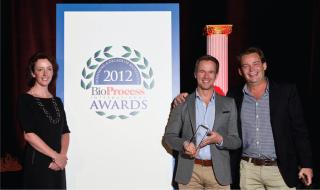
Our Event Sponsors Henrik Ihre (GE Healthcare) and Laurens Sierkstra (BAC BV) accepted the downstrem collaboration award. ()
Since 2006, GE Healthcare and BAC BV have had an ongoing, successful collaboration to develop products for improving manufacturing efficiency. This has led to the commercial launch of seven novel chromatography resins that are used in biomanufacturing worldwide. The work stemmed from BAC’s development of unique affinity ligands based upon single-domain antibody fragments. The collaboration brought this technology from research scale to the wider bioprocess community by delivering high-quality media based on those antibody fragments.
These results show how open innovation can bring high-quality and fit-for-purpose products to the market in a short time frame.
Sierkstra provided an update on the results of this collaboration: “Customers are already using our joint products within late-stage clinical programs including VIIISelect (for Factor VIII purification), AVB Sepharose (for Adeno-associated virus purification), KappaSelect (for antibody fragments), and VIISelect (for Factor VII/VIIa purification). The first drug using a BAC/GEHC purification product has just been approved for market.”
We asked him how this collaboration fits in with current industry trends. His reply was that “the industry is moving toward more ‘personalized’ products, which are effective only for smaller number of patients.” This is especially true for antibody–drug conjugates, bi-specifics and complicated therapeutic proteins, which will lower the dosing requirements due to their high effectiveness. Volumes of biopharmaceutical products will go down, and the products will become more high value per gram of product produced. Meaning that instead of a situation that focuses on reducing manufacturing costs, companies will move away from those types of high-volume products. For upstream processing, small and disposable fermentations will be at manufacturing scale, but this still leaves a need for the development of more efficient downstream processes.
Our Event Sponsors
Sponsor representatives presented the awards to our finalists and winners, thanking them directly for their service to the industry.
ATMI LifeSciences (Exclusive Upstream Processing Pillar Sponsor) represented by Jeff Craig Global Director, Business Development and Marketing
GE Healthcare Life Sciences (Exclusive Downstream Processing Pillar Sponsor) represented by Lorraine Attridge, Bioprocess ReadyToProcess Filtration and WAVE Business Leader
Life Technologies (Exclusive Manufacturing Pillar Sponsor) Life Technologies, represented by Nicole Brockway, associate vice president, market development
3M Purification (Supporting Sponsor)represented by Jason Walker, business unit manager
“Thus, as products become more complicated, high selectivity in the purification process will become key. For the new biopharmaceuticals, there will be no such thing as a platform product that does it all (such as protein A). This means that our product development capabilities to make targeted solutions for these types of molecules fits perfectly with where the industry is going.”
Thought Leader of the Decade Günter Jagschies — A Visionary Leader in Pursuit of Industrial Excellence (GE Healthcare)
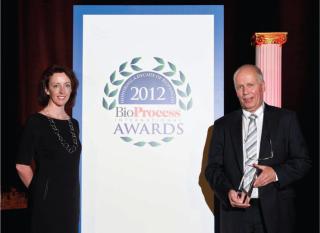
Our Thanks Also to … Günter Jagschies of GE Healthcare is honored with the downstream thought leader award. ()
The nomination form offers this testimonial: “Jagschies challenges the status quo in the industry through thought-provoking analyses of the state of manufacturing, industry trends, and corporate strategies. Employed by one of the industry’s largest suppliers, he objectively pursues industrial excellence in biotec
hnology. His greatest skill is an ability to anticipate trends and stimulate discussion long before issues become problems. In open forums, he encourages others to rethink the status quo — to analyze problems as a system, rather than as a sum of individual parts, putting commercial interests aside for the greater good of the industry.”
We asked Jagschies how his work reflects and furthers the work of the industry. He commented: “I’d like to believe that my work focus is on integrating aspects from all parts of process development and then processing at manufacturing scale; and integrating the biopharma industry and its technology and service vendors into one ‘story’ that then leads to ‘key questions’ and ‘challenges’ for all of us together. I am not a great believer in the island or bucket focus implying that, for example, upstream and downstream might be largely independent with room for uncoordinated improvements, and also without endorsement from the business part of any given company (just because the “science” can do it).
“The main trends in this industry — the increasing cost of R&D output, the need for efficiency improvements in PD, and the cost reduction demands in manufacturing — will not be addressed successfully with such simplification of the approaches. It may also be somewhat naïve to expect breakthroughs in certain technologies ‘just-in-time’ when we really need them. What is predictably successful, however, is to work on the use of technology in smarter ways and combinations. This is what process engineers do, and I foresee that discipline to have a lot more influence in our industry than ever before.”
He offered three predictions for the future. “I would like to believe that we will have witnessed the final breakthrough for single-use technology and a settlement on where it really adds value and where it doesn’t (because I do not believe it is the ‘cure-all’ approach that some people like to describe it as). There will be some distinct achievements leading to fixing the supply chains to pharmaceutical standards, closing most of the current technology availability gaps, improving the control and robustness of single-use operations to a level more easily acceptable by Pharma, and overcoming the remaining design and technology limitations (the design weaknesses in already available technology).
“Continuous and connected processing will be established in a number of cases significant enough to erode the skepticism and pave the way for more and more companies to go down that route.
“Related to biopharma common practice, I believe that the CMO industry and the whole aspect of outsourcing manufacturing will be undergoing a period of radical change in the coming decade. This is triggered by the availability of low-cost manufacturing facilities with a high degree of flexibility. Those biopharmaceutical players who have the people capabilities can adopt these facility designs and bring essentially all manufacturing home with good chances to improve their economics, too. In other words, there is a risk that CMOs will face a significant change of their client profiles and as a consequence, a restructuring of the business model. This comes along with the high titers, the possibility to scale down accordingly, and the establishment of single-use, cash-flow optimized manufacturing. It is an enabler for everyone who absolutely wishes to internalize manufacturing and the related capabilities. CMOs will need to be on their toes to be ready and competitive when this happens.”
Our Thanks Also to …
… our sales managers Chris Johnson, Mary Jane Riddell, and Mike Kelly; our sales and marketing coordinator Kim Rafferty; Heejung Alicia Yoo, assurance manager, audit and enterprise risk services of Deloitte & Touche LLP; Elizabeth Gormley managing director, IBC Life Sciences/BioProcess International; the BPI Conference managers and staff; the staff at the Providence Convention Center; and all of our readers and advisors who submitted nominations and helped provide valuable feedback about our process.
Manufacturing Pillar Winners
Technology of the Decade Steam-Thru Connections — Pioneering Technology for Hybrid Systems (Colder Products Company)

And Send Them Home Laughing! Sponsor Nicole Brockway presents the technology award to John Boehm, business unit manager of Colder Products Company ()
Steam-Thru connections represent the first technology to create sterile connections of stainless-steel processing equipment with single-use bag and tube assemblies. A three-port design allows for a steam-through process, eliminating “dead legs” and use of a laminar-flow hood.
Boehm offered his “take-home” impressions of our awards program. “The BPI awards program was an outstanding event that bestowed much deserved recognition to individuals, technologies, companies, and partnerships throughout the industry. It was a privilege for Colder Products Company to be recognized along with the prestigious nominees from all the various categories. A major take-away was that the industry has been and will continue to be pushed forward by new innovative technologies and partnerships. Upcoming advancements are likely to come from both large and small companies, with suppliers and drug manufacturers collaborating to meet the challenges of the next decade.”
We asked how his company’s award-winning technology has advanced, and where is it going now. “Steam-Thru Connection technology enables sterile connectivity between stainless steel equipment and single-use technologies. Hybrid system growth continues globally, especially in emerging markets where there is an installed base of stainless equipment. We continue to develop new sterile connector options that meet the industry’s need for easy-to-use connections that maintain the robustness and reliability required for the next generation of single-use systems.
“The robustness of single-use and hybrid systems depends on the reliability of each component that makes up the system; connectors are a key enabler for creating robust system and process design. We continue to work with both drug manufacturers and system suppliers to create new connection solutions covering a broad range of sterile fluid transfer needs from small-volume sampling to large volume reactors, mixers and transfer lines.”
Technology Application of the Decade Automated, Closed Single-Use Bioreactor for Cell Therapy Development (ReGenesys)
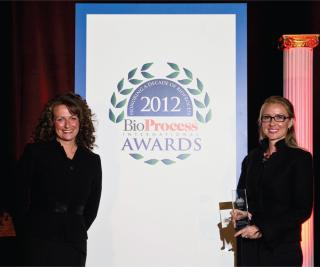
r: #f7f7f7;color:#000000;” >And Send Them Home Laughing! Rachel Killian accepted the technology application award on behalf of ReGenesys ()
Quantum Cell Expansion System technology, manufactured by TerumoBCT, streamlines cell culture processes, reducing contamination risk in clinical cell manufacturing. It brings automation, a closed environment, and process reproducibility to research, clinical trials, and commercial cell therapy development. The disposable bioreactor comprises thousands of hollow fibers, providing a large but compact surface area for cell attachment. Media and waste components pass through porous membranes while a gas transfer module regulates gas concentration. ReGenesys applied this technology to GMP production of MultiStem cells for initial clinical trials. The company anticipates easy scale-up using multiple machines to deliver consistently high-quality products.
According to the joint press release (http://newsroom.athersys.com/news/athersys-receives-cell-therapy-manufacturing-award), the work demonstrates that MultiStem cell therapy can be manufactured in an automated bioreactor system. Unlike other cell therapies, the product can be manufactured on a large scale, allowing up to a million or more doses to be produced from a single donor. Its unique biological characteristics allow for substantial expansion of the cell product in culture, while maintaining potency and product consistency.
“MultiStem has some key advantages relative to other cell therapy approaches, including superior expansion potential and scalability, as well as distinctive therapeutic properties. This award highlights the manufacturability of MultiStem cells in automated bioreactor systems,” said Robert Deans, executive vice president and head of regenerative medicine at Athersys. “We are excited by the progress made by our Belgian team and remain committed to developing the best-in-class commercial manufacturing platform.”
Collaboration of the Decade NIBRT (National Institute for Bioprocessing Research and Training; Irish Government, Industry, and Academia)
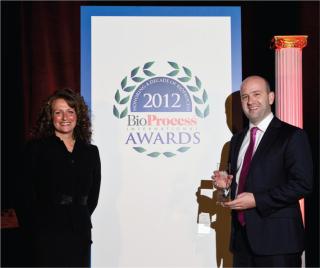
And Send Them Home Laughing! Ivan Houlihan, vice president of NIBRT, accepts the manufacturing collaboration award. ()
The Irish National Institute for Bioprocessing Research and Training (NIBRT, www.nibrt.ie) provides manufacturing research and training solutions to address key manufacturing challenges. This collaboration of government, industry, and academia drives process efficiencies, innovation, and compliance across all aspects of biopharmaceutical manufacturing. The stakeholders were united by a simple question: How can Ireland develop its position as a global center of excellence in the biopharmaceutical industry? The answer involved developing a facility that would help those stakeholders provide manufacturing research and training solutions to address the key manufacturing challenges facing the industry.
Projects have included optimizing an existing Escherichia coli process for interferon manufacture, enhancing glycan analytical capabilities, implementing advanced spectroscopic techniques, designing and implementing bespoke operations training programs, and rapidly and successfully starting up a new fill–finish vaccine facility.
The facility enables its industrial clients to share the load of plant start-up, personnel training, and R&D, and it has given Ireland a competitive market advantage. Its collaborations have been recognized by a number of industry awards, including a Special Recognition Award in the ISPE/Interphex Facility of the Year Awards 2012.
Thought Leader of the Decade Jerold Martin — Driving a Paradigm Shift in Biomanufacturing (Pall Corporation)

And Send Them Home Laughing! Jerry Martin of Pall Corporation accepts his award for thought leader of the decade in manufacturing. ()
Martin, a senior vice president for scientific global affairs for Pall Life Sciences, brings >35 years of experience in microbiology and technical services, R&D, and technical marketing, and as an industry/regulatory liaison. He has played a leading role in the implementation of single-use manufacturing in the biopharmaceutical industry, leading the Bio Process Systems Alliance (BPSA) in developing a series of consensus best-practice guides that have become broadly accepted. His promotion of single-use technologies sparked a paradigm shift for the industry, enabling companies to reduce capital costs and increase manufacturing flexibility.
Martin told us that he sees his award as “a recognition of the progress the industry has made in getting acceptance of the single-use concept and moving it from early adopters to clinical manufacturing to manufacturing of approved drugs and vaccines.” He hopes “to continue to address the challenges of single-use manufacturing to develop new drugs faster, to achieve improved drug safety, and to improve manufacturing cost effectiveness.”
Answering our question about what a BPI award program might honor in 2022, he comments, “I imagine we will see single-use manufacturing to be routine for batches
And Send Them Home Laughing!
Our program concluded with a comic address by Greg Schwem, nationally syndicated columnist, author, and humorous keynote speaker. Dubbed “king of the hill in the world of corporate comedy” by the Chicago Tribune, Greg regaled us with an outsider’s take on the biopharmaceutical industry. Who would have thought his research into the biotech industry’s acronyms, scientifically arcane terminologies, and Wikipedia entries would take him from “The Association for Technology in Music Instruction” (ATMI?) to … navel lint? (Don’t ask.) BPI thanks Greg for his skill in blending humor with insightful observations, revealing a genuine appreciation of our industry.
To learn more about him, please visit www.gregschwem.com.

You May Also Like